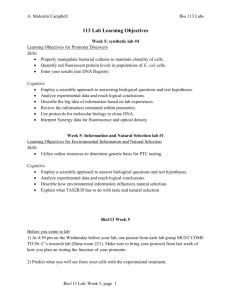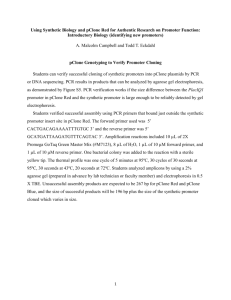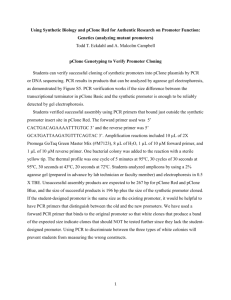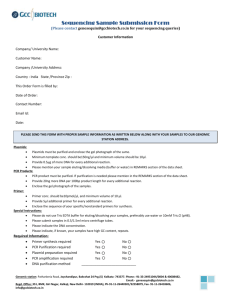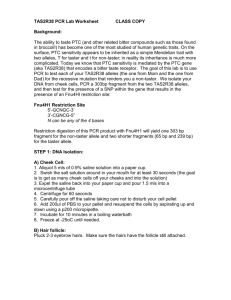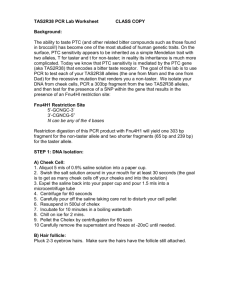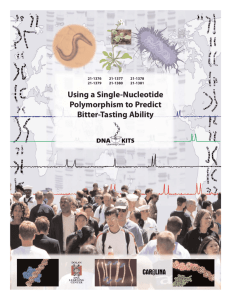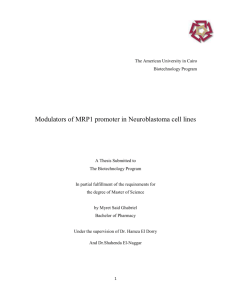Lab Manual Week #6
advertisement
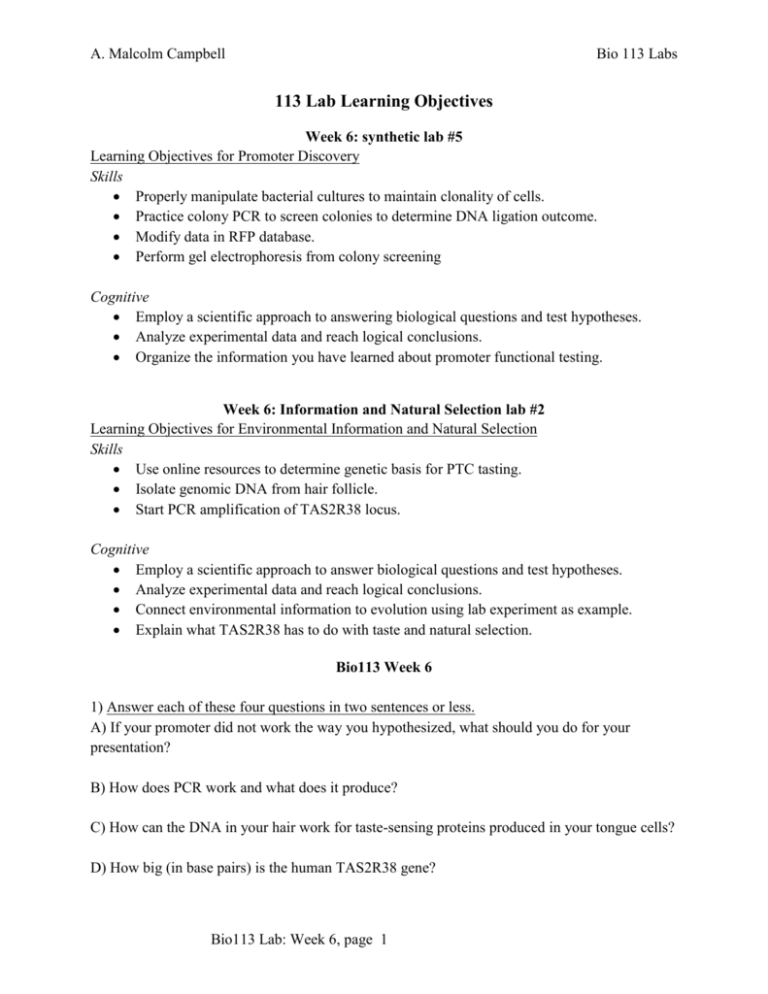
A. Malcolm Campbell Bio 113 Labs 113 Lab Learning Objectives Week 6: synthetic lab #5 Learning Objectives for Promoter Discovery Skills Properly manipulate bacterial cultures to maintain clonality of cells. Practice colony PCR to screen colonies to determine DNA ligation outcome. Modify data in RFP database. Perform gel electrophoresis from colony screening Cognitive Employ a scientific approach to answering biological questions and test hypotheses. Analyze experimental data and reach logical conclusions. Organize the information you have learned about promoter functional testing. Week 6: Information and Natural Selection lab #2 Learning Objectives for Environmental Information and Natural Selection Skills Use online resources to determine genetic basis for PTC tasting. Isolate genomic DNA from hair follicle. Start PCR amplification of TAS2R38 locus. Cognitive Employ a scientific approach to answer biological questions and test hypotheses. Analyze experimental data and reach logical conclusions. Connect environmental information to evolution using lab experiment as example. Explain what TAS2R38 has to do with taste and natural selection. Bio113 Week 6 1) Answer each of these four questions in two sentences or less. A) If your promoter did not work the way you hypothesized, what should you do for your presentation? B) How does PCR work and what does it produce? C) How can the DNA in your hair work for taste-sensing proteins produced in your tongue cells? D) How big (in base pairs) is the human TAS2R38 gene? Bio113 Lab: Week 6, page 1 A. Malcolm Campbell Bio 113 Labs Week 6 In Lab Information and Evolution: Genetics of Perceiving Danger Module (an 8 week project) 1) Isolate your genomic DNA using the online protocol. Use the thermocycler program called HAIR1. (See last page for details.) 2) Start the PCR of your TAS2R38 alleles. Use the thermocycler program called TAS2R38. (See last page for details.) Next week, you will send your DNA out for sequencing. 10 µL extracted genomic DNA 20 µL green GoTaq master mix + primers* 30 µL final volume Information: Design and Build a New Promoter (an 8 week project) 3) Make sure your results were uploaded to the Registry of DNA parts, including a graph for your new promoter. You must include a figure legend with your figure. Search for your part number and log in to make changes. 4) Discuss how you want to present your data about your promoter research. Generate any figures you might need. Look over all the photos you have taken. Be sure you know all the concentrations and other experimental details. 5) Complete CATME. Bio113 Lab: Week 6, page 2 A. Malcolm Campbell Bio 113 Labs Key Reagents for TAS2R38 PCR Hair extraction buffer: 300 mL water 1.86 g KCl 0.61 g Tris 0.25 g MgCl2 (6H2O) 0.05 g gelatin 2.25 mL IGEPAL CA-630 (see Wikipedia entry) 2.25 mL Tween 20 Mix while warming, and allow to cool. pH to 8.3 at RT with HCl bring up to 500 mL with water and autoclave. Looks white until it cools. Store 1 mL aliquots in fridge. Just before use, thaw one aliquot of proteinase K (10 mg/mL) and store on ice. Put 12 µL of proteinase K into 2 mL extraction buffer. Mix well. Use 100 µL extraction buffer for each hair sample. *Promega green GoTaq master mix + primers: 15 µL 2X green GoTaq master mix + 3 µL water + 1 µL forward primer + 1 µL reverse primer PCR conditions: 95° C for 5 minutes 95° C for 30 seconds 56° C for 30 seconds 72° C for 1 minute repeat 29 more times hold at 22° C Forward Primer Sequence 5’ CATCCGCACTGTGTCCTATG 3’ Reverse Primer Sequence 5’ GGCTCTTACCTTCAGGCTGC 3’ Sequencing primer for TAS2R38 5’ AGTGGGGTTTCTGACCAATG 3’ Bio113 Lab: Week 6, page 3
